| Pages:
1
..
3
4
5
6
7
..
24 |
Poppy
Hazard to Others
  
Posts: 294
Registered: 3-11-2011
Member Is Offline
Mood: † chemical zombie
|
|
Hello, so has your method really succeded? good job!!
Thank you!
As in the case of the autoprotolysis I meant some Fe(OH)3 changes in situ into Fe2O3 because the autoprotolysys mechanism, as evidenced by the
Schikorr reaction
Sorry for the misleading with the equation for O(2-).
Schikorr reaction starts at about 100ºC and increases as temperature goes up. At temperatures <100ºC the conversion of Fe(OH)3 into Fe2O3 is not
even likely to occur, but my advice is to beware of high temperatures!
------------------------
Blogfast:
I get it now, Fe(OH)3 = Fe2O3.n H2O = HFeO2 = FeO(OH) in a different notation.
But powdered dry Fe2O3 would not turn into Fe2O3.n H2O by damping in water correct?
Heating 2 HFeO2 (the mud from reaction of FeIII ions with strong alkali) to 200ºC dehydrated it into Fe2O3.
Would this dry Fe2O3 work too???
For those who wants Fe(OH)3 but are not dealing with H2O2, you can prepare it without H2O2, following this long road production, starting with
Schikorr reaction and then drying.
------------------------------------------
2 (Fe2+ → Fe3+ + e–) (oxidation of 2 iron(II) ions)
2 (H2O + e– → ½ H2 + OH–) (reduction of 2 water protons)
To give:
2 Fe2+ + 2 H2O → 2 Fe3+ + H2 + 2 OH–
Adding to this reaction one intact iron(II) ion for each two oxidized iron(II) ions leads to:
3 Fe2+ + 2 H2O → Fe2+ + 2 Fe3+ + H2 + 2 OH–
For electrical neutrality, OH(-) are shown:
3 Fe2+ + 6 OH– + 2 H2O → Fe2+ + 2 Fe3+ + H2 + 8 OH–
3 Fe(OH)2 + 2 H2O → Fe(OH)2 + 2 Fe(OH)3 + H2
Autoprotolysys mechanism: Its essential in the formation of the final product and occurs but only at temperatures about 100ºC or above.
OH– + OH– → O2– + H2O
acid 1 + base 2 → base 1 + acid 2, or also,
2 OH– → O2– + H2O
Then that all progresses as
3 Fe(OH)2 + 2 H2O → (FeO + H2O) + (Fe2O3 + 3 H2O) + H2
3 Fe(OH)2 + 2 H2O → FeO + Fe2O3 + 4 H2O + H2
3 Fe(OH)2 → FeO + Fe2O3 + 2 H2O + H2
The former Schikorr reaction being
3 Fe(OH)2 → Fe3O4 + 2 H2O + H2
I will make a test with Fe(OH)3 as soon as providing some HCl and H2O2 to see if it protolyses into pure Fe2O3!!
For that I'll just heat the ferric hydroxide mud until dryness and somehow check for pure Fe2O3 for its beatyful red color.
Another note, when preparing conventional Schikorr reaction for the production of magnetite, leaving the heating vessel with any opening causes oxygen
to enter like crazy and get absorbed by the magnetite turning it into orange Fe2O3, which is a mixture consisting of mostly Fe2O3 and a little bit
FeO.
2 Fe3O4 + 1/2 O2 --> 3 Fe2O3
The reaction with atmospheric oxygen was so strong that at 100ºC finely ground magnetite was actually burning!
The test for this orange Fe2O3 was made diluting it into 30% HCl and observing that some residue of FeO (black) was not atacked even with overweighted
HCl.
Further burning of the oxide mix seemed not to oxydise anymore FeO.
The Fe2O3 can be dissolved in sulphuric acid and then put to react with strong alkali to produce Fe(OH)3.
[Edited on 11-12-2011 by Poppy]
[Edited on 11-12-2011 by Poppy]
|
|
|
Wizzard
Hazard to Others
  
Posts: 337
Registered: 22-3-2010
Member Is Offline
Mood: No Mood
|
|
Alright, I'm first going to admit I have absolutely no formal training in chemistry- I'm strictly a math major 
But I noticed over a weeklong evaporation operation- The nd sulfate fell out first, in both cases, so much so that it was able to crystallize, and
appears nearly Fe free.
Iron sulfate is VERY soluable at ~95*C, the Nd sulfate is not... Am I the only person evaporating the water out slowly at just below boiling, causing
the Nd to drop out selectively?
I can post some pictures, I'm working on narrowing down the time spend evaporating- So far, I manage to drop out all the ND sulfates, and then the
iron sulfates right down on top of it (but the layering is very distinct).
|
|
|
blogfast25
International Hazard
    
Posts: 10562
Registered: 3-2-2008
Location: Neverland
Member Is Offline
Mood: No Mood
|
|
No, it needs to be sufficiently hydrated (‘freshly’ precipitated) to still react with low concentrations of H3O+: Fe(OH)3 + 3 H3O+ === > Fe3+ +
2H2O.
Quote: Originally posted by Wizzard  | But I noticed over a weeklong evaporation operation- The nd sulfate fell out first, in both cases, so much so that it was able to crystallize, and
appears nearly Fe free.
|
Welcome to the murky world of hobby chemistry, mathman!
Do NOT let appearances fool you: at least with the double salt (presumed Nd2(SO4).K2SO4.2H2O) I’ve obtained a nice, pink product which on further
scrutiny contained… substantial amounts of iron! There seems to be co-precipitation going on. Whether that is also the case with
‘naked’ Nd2(SO4)4 I cannot vouch for. Test by converting your sulphate to hydroxide by treating with strong alkali. Filter off the precipitate and
wash it, then dissolve it in clean (iron free) HCl. Add a bit of 9 % H2O2 to oxidise any Fe2+ to Fe3+. Test visually or with KSCN.
I wonder also about the iron content of Nd oxalate precipitated from iron rich solutions, see Mr Home Scientist higher up and kmno4 in a separate Nd
thread...
£$£$£$£$£$£$
Well, here’s my ‘magnet chloride’ after heating and standing overnight:

Plenty of precipitated Fe(H)3 but the dark red-brownish supernatant liquid is the tell tale that plenty of Fe didn’t drop out. pH was less than 1 at
that point, so no surprise there.
After that the work became more of a rescue operation than a chemical separation!
The slurry filtered only with great difficulty and adding some freshly precipitated Fe(OH)3 did not bring the pH up enough to precipitate the
remaining dissolved iron. I had to resort to manually adjusting the pH to pH >= 4, first with small amounts of 5 M NaOH, the final adjustment with
household ammonia. At that point the slurry became much thicker and filtered better. The filtrate contained all the Nd, but still tested slightly
positive for Fe3+, mainly due to a bit of colloidal Fe(OH)3 running through the filter I believe. The raw NdCl3 has now been precipitated one last
time and will be redissolved in HCl tomorrow.
In conclusion I’d say that separating Nd3+anf Fe3+ by playing to the Fe(OH)3 equilibrium works best for removing relatively small amounts of
iron, not to remove iron in concentrations 7 times or larger than that of Nd3+.
[Edited on 13-11-2011 by blogfast25]
|
|
|
Wizzard
Hazard to Others
  
Posts: 337
Registered: 22-3-2010
Member Is Offline
Mood: No Mood
|
|
Will test once I get home  It all dissolved in 15cc of very cold water (1-2*C),
about .5g of the physically extracted Nd salt (scraped from the bottom- It's much softer than the very hard iron sulfate. Very faint purple color. I'm
working on getting the rest out, by watching the evaporative process carefully. It all dissolved in 15cc of very cold water (1-2*C),
about .5g of the physically extracted Nd salt (scraped from the bottom- It's much softer than the very hard iron sulfate. Very faint purple color. I'm
working on getting the rest out, by watching the evaporative process carefully.
I only was seeing purity because the Nd salt crystallized- I know some purity is needed for this. There were small 2-3mm crystals among the mess on
the bottom of the container.
|
|
|
blogfast25
International Hazard
    
Posts: 10562
Registered: 3-2-2008
Location: Neverland
Member Is Offline
Mood: No Mood
|
|
Ok wizzard, what was your 'mother liquor' made from? 'magnet sulphate'? Did you simply dissolve a magnet in H2SO4? Then what do you do next?
Also, when you refer to 'iron sulphate', do you mean ferric or ferrous sulphate?
|
|
|
Wizzard
Hazard to Others
  
Posts: 337
Registered: 22-3-2010
Member Is Offline
Mood: No Mood
|
|
Mother aqueous solution was 'magnet sulfide', with the nickel COMPLETELY removed manually.
Then left to dissolve, in full, the remaining slush of unknown material and boron removed. (pic 1)
From this, total evaporation with small addition of distilled solution, but still acidic (I did not test pH).
From this, the layered substance in photo 2.
Scraping the purple Neodymium Sulfate into a glass (a small sample amount), dissolved and nearly frozen, then dried on a hot plate over the course of
6 hours, the resulting pure crystals formed- Picture 3 in 4 parts 
My method seems low yield, but very easy! I prefer manual means- Not so much measurement (but I would like to learn). I'm a scientist for sure, but a
chemist I am not!
The largest (centered) crystal cluster is about 7-8mm across.
@Blogfast- Ferrous, Iron(II) of course 
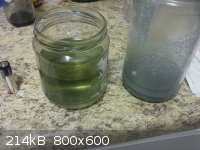 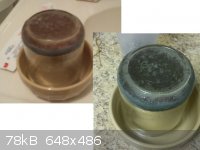 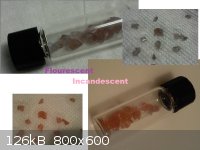
[Edited on 11-14-2011 by Wizzard]
|
|
|
blogfast25
International Hazard
    
Posts: 10562
Registered: 3-2-2008
Location: Neverland
Member Is Offline
Mood: No Mood
|
|
So, if I understand well you simply slowly evaporated the ,magnet sulphate' until crystals of Nd2(SO4)3 started to appear? Certainly the Nd sulphate
is much less soluble than ferrous sulphate but it's interesting you managed to isolate the minority constituent that way and of seemingly good quality
too. AFAIK no one else has applied that approach here yet. Personally I had trouble dissolving the magnet in 50 % H2SO4, not sure why...
I would still urge you to test one crystal for presence of iron.  If contaminated
you could recrystallise for instance, or did you already do that? If contaminated
you could recrystallise for instance, or did you already do that?
[Edited on 14-11-2011 by blogfast25]
|
|
|
Wizzard
Hazard to Others
  
Posts: 337
Registered: 22-3-2010
Member Is Offline
Mood: No Mood
|
|
Yes, after filtering out the insoluables, the Nd fell out of solution before the Fe did with slow evaporation at 90-95*c.
I will test for iron once I get my hands on some good hydrogen peroxide... My lab chemical supply is still expanding.
I have not recrystallized a second time, only a first. I could do it a second, but I fear there is little enough already! I'll wait until the larger
batch I have going right now finishes.
|
|
|
blogfast25
International Hazard
    
Posts: 10562
Registered: 3-2-2008
Location: Neverland
Member Is Offline
Mood: No Mood
|
|
Quote: Originally posted by Wizzard  | Yes, after filtering out the insoluables, the Nd fell out of solution before the Fe did with slow evaporation at 90-95*c.
I will test for iron once I get my hands on some good hydrogen peroxide... My lab chemical supply is still expanding.
|
It's quite amazing you got crystals rather than microcrystals (powder). You must have gotten a bit lucky there, I'm guessing; right water-to-salt
ratio and all that... It's also surprising your that your ferrous sulphate wasn't more oxidised by air and heat: it then has a tendency to drop out.
3 or 9 % H2O2 from a pharmacy will do. It's dirt cheap.
[Edited on 14-11-2011 by blogfast25]
|
|
|
Wizzard
Hazard to Others
  
Posts: 337
Registered: 22-3-2010
Member Is Offline
Mood: No Mood
|
|
Well I know from experience that ferrous sulfate oxidizes with contact to air in solution, unless kept mildly acidic... I've grown 1cm crystals in 2cm
tubes  I'm no chemist, but I do know a thing or two about keeping one's
ingredients pure- I've been growing crystals of various salts since I was in high school. I'm no chemist, but I do know a thing or two about keeping one's
ingredients pure- I've been growing crystals of various salts since I was in high school.
And I was unaware that pharmacy grade H2O2 is good enough! Off I go!
Attached good macro pic, with scale.
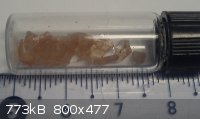
[Edited on 11-14-2011 by Wizzard]
|
|
|
blogfast25
International Hazard
    
Posts: 10562
Registered: 3-2-2008
Location: Neverland
Member Is Offline
Mood: No Mood
|
|
Very nice crystals indeed: they look good enough to eat! 
Do you recall:
* weight of the magnet
* amount and concentration of the sulphuric acid used?
Did you get any early precipitation (of Nd2(SO4)3) during dissolving?
Acidity slows the oxidation of Fe (II) down, that's very true. But you should have seen my acidic stockpile of FeCl2 crystals after a couple of weeks:
it's a brown mass of Fe(OH)3, ferric oxychlorides and what not: I bet it would test negative for Fe (II)! Just for standing in open air...
|
|
|
Wizzard
Hazard to Others
  
Posts: 337
Registered: 22-3-2010
Member Is Offline
Mood: No Mood
|
|
The approximate weight of the magnets, before breaking up and removing the plating, was about 200g- I'd say 125-150g of magnet material went in.
I then added about equal parts distilled water and 98% sulfuric acid, maybe 50ccs total. When the boiling would stop, I would add more conc. sulfuric
acid or water (4ccs at a time), depending on what the solution wanted, and I did this many times. It sometimes would run out of acid (and a light
tinge of yellow iron hydr/oxide would form on the meniscus) or it would cease when it ran out of water. When it stopped and only small bubbles would
come out of the insoluable slush at the bottom for some hours (and sometimes only when shaken slightly), then it was time to filter.
No visible precipitation occurred as the solution was made, but there could be some in the insoluable mess. It did sometimes have a tinge of purple. I
am working on extracting what remaining material I can from it.
The solution was kept at room temperature while dissolving- Only in the end did I heat it (to wrap up any action of the sulfuric acid, at least 90*C)
before I froze it (about 5*C), then filtered it cold (maximizing output of the Nd sulfate).
|
|
|
barley81
Hazard to Others
  
Posts: 481
Registered: 9-5-2011
Member Is Offline
Mood: No Mood
|
|
Really? I thought it did, after reading this:
http://woelen.homescience.net/science/chem/solutions/fe.html
|
|
|
blogfast25
International Hazard
    
Posts: 10562
Registered: 3-2-2008
Location: Neverland
Member Is Offline
Mood: No Mood
|
|
I think it's a matter of debate, TBH. If Fe IV really does exist it must be very unstable.
@Wizzard:
I see. Well, maybe next time I'll try again with fully peeled magnets and a stoichiometrically determined amount of H2SO4...
[Edited on 14-11-2011 by blogfast25]
|
|
|
Wizzard
Hazard to Others
  
Posts: 337
Registered: 22-3-2010
Member Is Offline
Mood: No Mood
|
|
I'll run another batch, fully documented 
I have stacks of old HDDs and all the motivation I need for beautiful, hexagonal air semi-stable (left one on the paper overnight- no water loss!!)
color changing crystals of an element I have very little of in my collection.
|
|
|
blogfast25
International Hazard
    
Posts: 10562
Registered: 3-2-2008
Location: Neverland
Member Is Offline
Mood: No Mood
|
|
Lucky mathman! I asked a computer repair shop to keep any duff HDDs for me (for a token price) but it turns out they 'forgot'. Barstools.
The crystals, being of a compound that's not particularly highly soluble nor insoluble, should be neither particularly deliquiescent nor efflorescent,
IMHO... My NdCl3 on the other hand deliquiesced like mad: very hygroscopic.
|
|
|
Poppy
Hazard to Others
  
Posts: 294
Registered: 3-11-2011
Member Is Offline
Mood: † chemical zombie
|
|
Wizzard:
I would assume you just filtered the liquor out of the muddy magnet solution: this little ammount of liquor justifies the nicely dissolved Nd2(SO4)3
in there, and very small yield for 125g?
Also we must point out your evaporation method is a very good way for 1 stepped refining of neodimium sulphate., good job.
|
|
|
Wizzard
Hazard to Others
  
Posts: 337
Registered: 22-3-2010
Member Is Offline
Mood: No Mood
|
|
Thanks! Very small yield was due to my physical method of separating the Nd salt from the Fe salt- I merely scraped the easiest-to-get-at soft/wet and
purple neodymium sulfate crystal from the hard, green ferrous sulfate.
Low yield, yes, but I'm still extracting the salts from that aqueous solution- This was just a quick and dirty trial. I'd also still say there's 50%
more in my evaporation dish- There was a good quantity of smaller crystals, but I do need to remove the film which grew on the edges before I
reattempt this (and recycle the dried and extracted but not removed Nd sulfate).
Partial evaporation yielded the following crystals- Such a lovely color! Recrystallizing tonite- It doesn't take long. Note the green tinge in the
center mass, and along the edges- This is the start of when the iron sulfate crystallizes- Time to stop evaporating!
[Edited on 11-14-2011 by Wizzard]
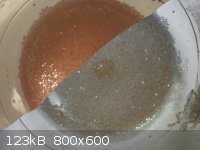
|
|
|
blogfast25
International Hazard
    
Posts: 10562
Registered: 3-2-2008
Location: Neverland
Member Is Offline
Mood: No Mood
|
|
Wizzard:
Although I had come to believe that your crystals must be high purity and essentially free of iron, now I’m not so sure anymore or at least a little
befuddled. A spammer inadvertently dragged up this old post on neodymium sulphate:
http://www.sciencemadness.org/talk/viewthread.php?tid=12934#...
(go to the last post by kmno4)
The colour obtained by you seems highly unusual.
I will now cross-post your results into that thread.
|
|
|
Wizzard
Hazard to Others
  
Posts: 337
Registered: 22-3-2010
Member Is Offline
Mood: No Mood
|
|
My lighting conditions are a normal 60W incandescent, and big-bulb commercial flourescent lighting. Perhaps I'll get a sunlight shot today- That will
be nice for comparison.
My are certainly a bit more pink/red than those purple/pink ones you link to- But I will say I cant wait to grow a single crystal that size 
[Edited on 11-15-2011 by Wizzard]
|
|
|
Poppy
Hazard to Others
  
Posts: 294
Registered: 3-11-2011
Member Is Offline
Mood: † chemical zombie
|
|
On the the leftover liquor:
After separating in part the neodimium from iron from a magnet solution via the sulphate method, a leftover supernatant was obteined which seemed to
contain, by its color, initially at least a big portion of Fe III sulphate, Fe II sulphate, unnoticeable by eye, and some neodimium as well.
Theoretical obtention of Nd2(SO4)3.8H2O would be slightly round 50g, but as there was obteined just 44g (oops, thats really close to the goal, and
because some 5g were lost propositally =P) I am inclined to believe some neodimium was left in the supernatant solution (at least 6g) as well as some
iron is present in my final powder.
The main reason is that the leftover supernatant gradually, and very slowly, formed crystals which took much longer than conventional ferrous sulphate
crystals to form (6 hours for a supersaturated solution of FeSO4 and one week to badly precipitate some of the strange liquor).
Here you can see the leftover after about 2 days:
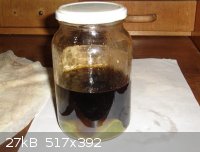 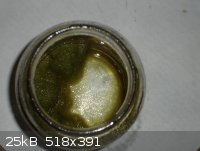
Here you can see the leftover solution after about 1 week:
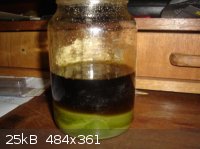
Those crystals were filtered and dissolved again to see what happens: the result was a slightly pink solution from those green crystals!!!!
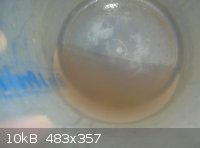 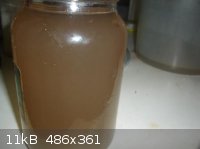
That after decanting (seeing pink depends on your mood on that day...)
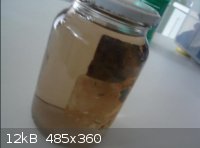
The green crystals initially become decoloured when washed
then gives the solution above.
So there must be double salts of Nd, Fe in the solution which modifies how the precipitation of pure ferrous sulphate crystals would do, and my
obteined Nd salt powder is highly contamined with Pr or Fe in order of having its yellow color, even after it was thorughly washed with hot water when
it was prepared.
And this is the Nd sulphate under flash and daylight, theres no real difference.
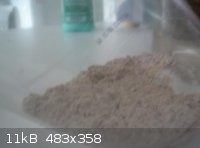 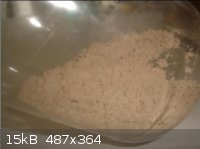
[Edited on 11-15-2011 by Poppy]
|
|
|
blogfast25
International Hazard
    
Posts: 10562
Registered: 3-2-2008
Location: Neverland
Member Is Offline
Mood: No Mood
|
|
Quote: Originally posted by Poppy  | On the the leftover liquor:
After separating in part the neodimium from iron from a magnet solution via the sulphate method, a leftover supernatant was obteined which seemed to
contain, by its color, initially at least a big portion of Fe III sulphate, Fe II sulphate, unnoticeable by eye, and some neodimium as well.
Theoretical obtention of Nd2(SO4)3.9H2O would be slightly round 50g, but as there was obteined just 44g (oops, thats really close to the goal, and
because some 5g were lost propositally =P) |
Can you describe what you did slightly more in detail?
Also, literature describes an octahydrate (.8H2O), not a nonahydrate (.9H2O)...
Edit:
Dang!! Quite a bit of confusion on the colour of neodymium sulphate: higher up in this thread:
http://www.sciencemadness.org/talk/viewthread.php?tid=14145&...
Quote: Originally posted by DerAlte  | All references I have seen say Nd sulphate is red (my emph.) and Sm is light yellow, Ce white (colourless); and these were the colors
I got. All these sulphates are very difficult to dissolve at 0C, the most soluble point. Once dissolved, heating to 100C usually will precipitate
them. Better crystals can be obtained by slow evaporation.
Regards, Der Alte |
This photobucket entry which shows crystals very much like Wizzard’s:
http://media.photobucket.com/image/neodymium%20sulphate%20cr...
And here, slightly more pinkish:
http://www.metall.com.cn/ndso.htm
[Edited on 15-11-2011 by blogfast25]
[Edited on 15-11-2011 by blogfast25]
|
|
|
Wizzard
Hazard to Others
  
Posts: 337
Registered: 22-3-2010
Member Is Offline
Mood: No Mood
|
|
It's quite possible there's some other Lanthanide impurity involved there- Neodymium magnets dont need absolute purity, as far as the Nd is concerned,
I think (and was this also mentioned previously in this thread?).
|
|
|
blogfast25
International Hazard
    
Posts: 10562
Registered: 3-2-2008
Location: Neverland
Member Is Offline
Mood: No Mood
|
|
Quote: Originally posted by Wizzard  | | It's quite possible there's some other Lanthanide impurity involved there- Neodymium magnets dont need absolute purity, as far as the Nd is concerned,
I think (and was this also mentioned previously in this thread?). |
Actually I believe it was praseodymium that was mentioned by kmno4. Absolute purity of Nd for magnets is probably not a prerequisite but to affect
colour you'd need substantial contamination (I think).
Other things that might affect colour could be:
* light (UV content): already accounted for
* powder (microcrystaline) v. macro crystals
* variability in hydration (.xH2O). It's well known the lower hydrates (generally speaking - not spec. to Nd) tend to form at higher temps. and vice
versa.
Looking at the body of evidence, yours seem to have the 'right' colour though...
|
|
|
Wizzard
Hazard to Others
  
Posts: 337
Registered: 22-3-2010
Member Is Offline
Mood: No Mood
|
|
What I'll experiment with next will be how much alcohol I can add to the water solution of high-Nd/low-Fe and plot the soluability tables with
different mixtures of alcohol/water down to -10*C (the limits of my scientific "Wal-Mart" mini-fridge).
Maybe with some alcohol, I can lower temperatures and dissolve more Nd sulfate, and drop out more Fe sulfate.
|
|
|
| Pages:
1
..
3
4
5
6
7
..
24 |